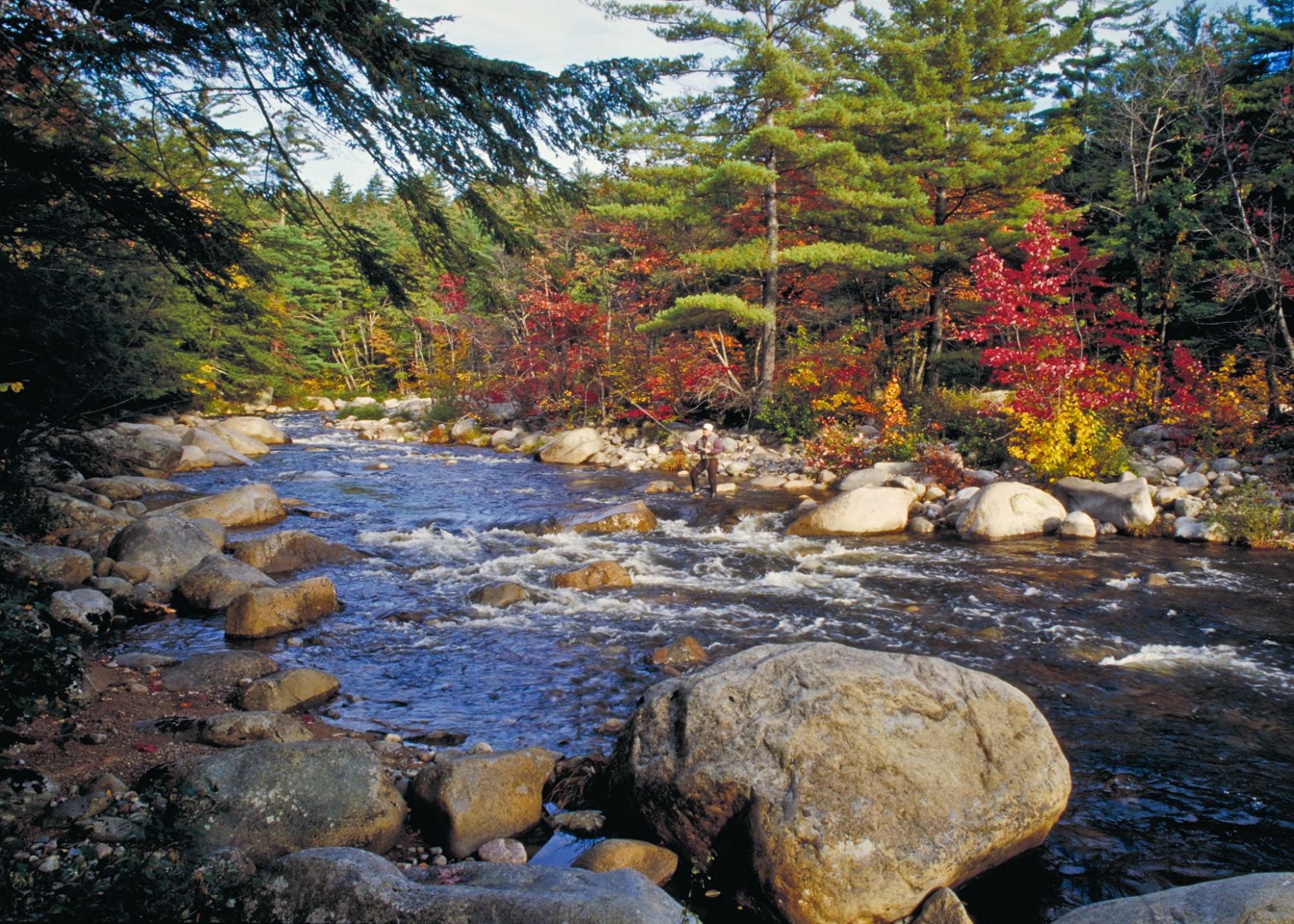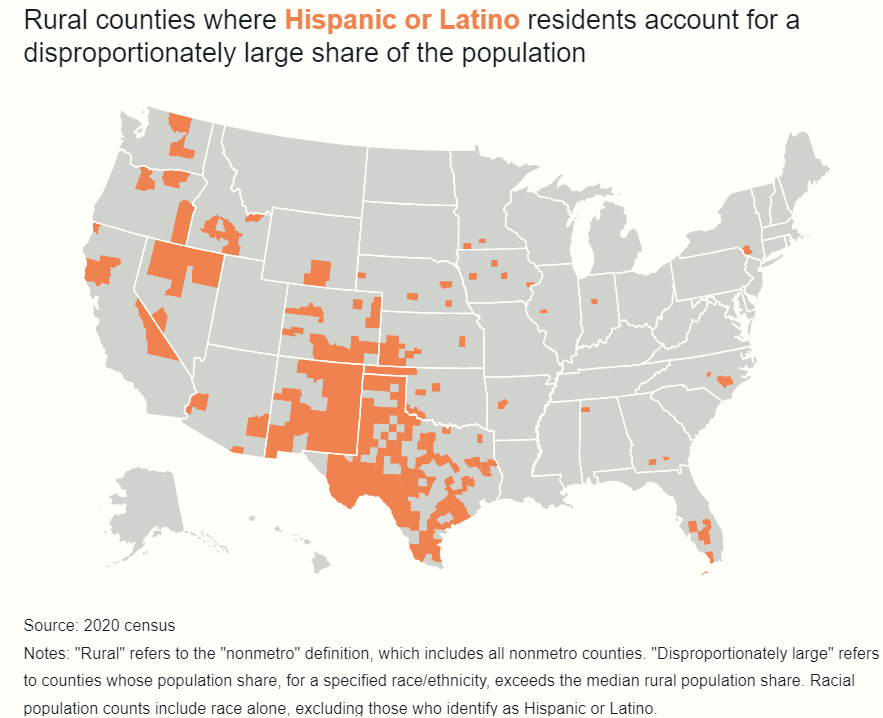6.5 Migration and Immigration to Rural America
While the global population trends toward urbanization, there are some attractions that continue to bring people to rural areas. For example, many small towns have become hubs for retirement or tourism. Outdoor recreation opportunities and beautiful natural landscapes bring people of all ages to rural areas, too. Economic opportunities related to natural resource extraction in rural areas (e.g., oil, gold, etc.) create “boomtowns” that have historically been flooded by men in search of jobs and wealth. Geographic isolation might make remote rural areas attractive to religious or other ideologically based groups (e.g., Amish people, cults, “preppers,” militias, etc.) that want to remain hidden or escape the modern metropolitan world.

The movement of people in and out of rural communities can pose both real and imagined challenges for the locals, as well as social justice issues. A town of 3,000 will likely have a very small police department with a maximum of only a few officers. Even if the police generally do an excellent job of crime control and prevention, a sudden and drastic change in the population will impact their ability to do the job. For example, just addressing traffic concerns in that 3,000-person town when it holds a large event every month may prove difficult for law enforcement. Additionally, dense and strong social networks in rural communities lead to “othering” of those who do not fit the social norms. Because the distinction between outsiders and insiders in small-town and rural communities can be stark, those who move to these areas temporarily or permanently may struggle to fit in.
Rural Hispanic and Latinx Populations
The Hispanic and Latinx community has a rich history and deep roots in the United States, from the vaqueros mentioned earlier to the many cultural contributions to American society. The Hispanic population, including those with roots in Spain, Mexico, Central or South America, and the Spanish-speaking countries of the Caribbean, is the largest racial or ethnic minority in the United States and accounts for 19 percent of the country’s total population (USCB, 2023). While 68 percent of the Hispanic and Latinx people were born in the United States, recent trends in immigration of people from Mexico and South American countries have greatly contributed to changing demographics in the United States (USCB, 2022). Many people who immigrate, especially those from Mexico, find themselves settling in rural areas to work in meatpacking plants, farms, or industries such as construction, oil, and timber. In 2020, population gains in many rural areas were solely driven by the increase in Latinx residents and contributed to the nearly 10 percent total rural Hispanic and Latinx population (Rowlands and Love, 2021). As seen in Figure 6.22, the rural Hispanic and Latinx population is mostly concentrated in the Southern, Western, and Midwestern regions of the United States.

There are over 2 million farms in the United States, many of which are located in rural communities (Economic Research Service, 2023). The agricultural industry, especially large commercial farms, relies on workers who were not born in the United States. In 2017, nearly half of hired crop workers lacked the immigration status legally required to be employed in the United States (USDOL, ETA, 2017; Zahniser et al., 2018). People who immigrate from Mexico or South America play a significant role in the American food and agriculture industry. As of 2022, Hispanic people of any race made up 3 percent of the total farm producers in the United States, making them the largest group of minority farmers in the country (Department of Agriculture, 2024).
Research shows that Americans, especially in rural areas, are fearful that immigrant workforce laborers will increase crime in their communities. Such fears are exacerbated by political campaigns such as Trump’s push to “build the wall” (see Chapter 5 for more discussion on how immigration issues are policed). However, these fears are not substantiated by research on crime. In 2020, an analysis of data from the Texas Department of Public Safety showed a lower felony arrest rate among undocumented immigrants when compared to both legal immigrants and native-born people in the United States (Light et al., 2020). Looking at farm-related crime specifically and using 2015 data from the National Incident-Based Reporting System, researchers found that farm crime offenders tended to be young white males who lived in the area (Osborne et al., 2019), not outsiders with brown or black skin.
One potential explanation for prejudice against “others” is provided by the Social Threat Hypothesis, similar to Group Threat Theory that was discussed in Chapter 2. This hypothesis asserts that dominant groups in society may feel that their way of life is being threatened by disadvantaged groups, and they might take action to protect their power and the status quo. White people in predominantly white rural areas may express intolerance of immigrants and people of color if they perceive them as a threat to their norms and traditions. Rhetoric that is common among the “build the wall” crowd directly speaks to the distrust, dislike, and fear of people coming from Spanish-speaking countries (especially Mexico) who are deemed as threats to American life.
Check Your Knowledge
Licenses and Attributions for Migration and Immigration to Rural America
Open Content, Original
“Migration and Immigration to Rural America” by Jessica René Peterson is licensed under CC BY 4.0.
Open Content, Shared Previously
Figure 6.21. Image by Elaine Brewer is licensed under the Unsplash License.
All Rights Reserved Content
Figure 6.22. The map by the Center on Rural Innovation is included under fair use.
movement of people from rural settings to cities and metropolitan areas that results in the growth of urban places
simply put, non-urban spaces with lower populations and lots of undeveloped land
a group of people living in a defined geographic area that has a common culture
a category of people grouped because they share inherited physical characteristics that are identifiable, such as skin color, hair texture, facial features, and stature
an individual attitude based on inflexible and irrational generalizations about a group of people and literally means “judging before.”
Asserts that dominant groups in society may feel that their way of life is being threatened by disadvantaged groups and might take action to protect their power and the status quo

